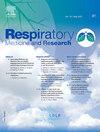Pulmonary ultrasound versus chest radiography in the diagnosis of community-acquired pneumonia in adults: an updated systematic review and meta-analysis
IF 1.8
4区 医学
Q3 RESPIRATORY SYSTEM
引用次数: 0
Abstract
Introduction
Although chest radiography (CXR) has traditionally been used as the initial diagnostic test, pulmonary ultrasound (US) has emerged in recent years as a radiation-free, portable, and potentially more sensitive and specific alternative.
Objective
To evaluate the diagnostic accuracy of US compared to CXR for detecting community-acquired pneumonia (CAP) in adults through a systematic review and meta-analysis.
Methodology
Comprehensive searches were conducted in SCOPUS, Web of Science, PubMed, and EMBASE databases. Observational studies comparing US with CXR in diagnosing CAP were included, using computed tomography as the reference standard for all patients. Random-effect models were used for statistical analysis, calculating sensitivity, specificity, likelihood ratios (LR), and diagnostic odds ratios (DOR). Meta-regression analyses were performed, and SROC curves were constructed to compare diagnostic performance.
Results
Eight studies using CT as a reference standard were included. US showed superior performance with sensitivity 90.0 % (95 % CI: 81.3-96.2 %), specificity 90.8 % (95 % CI: 79.9-97.7 %), LR+ 9.45 (95 % CI: 3.73-23.94), LR- 0.12 (95 % CI: 0.06-0.24), and DOR 79.74. CXR demonstrated lower values with sensitivity 72.6 % (95 % CI: 61.7–82.4 %), specificity 82.0 % (95 % CI: 65.5–93.9 %), LR+ 3.98 (95 % CI: 1.87-8.49), LR- 0.36 (95 % CI: 0.23-0.54), and DOR 11.17. Both modalities showed significant heterogeneity, which was not explained by the sample size in meta-regression.
Conclusions
Pulmonary US demonstrates substantially higher diagnostic accuracy than CXR for CAP detection, with particularly strong performance in excluding pneumonia as evidenced by its low negative LR. While CXR maintains relevance where US is unavailable or for evaluating specific thoracic conditions, implementing US can optimize pneumonia diagnosis and potentially reduce unnecessary antibiotic use, particularly in emergency and critical care settings.
肺超声与胸片在成人社区获得性肺炎诊断中的比较:一项最新的系统综述和荟萃分析
虽然胸部x线摄影(CXR)传统上被用作最初的诊断测试,但近年来,肺超声(US)作为一种无辐射、便携式、可能更敏感和特异性的替代方法出现。目的通过系统回顾和荟萃分析,评价US与CXR在检测成人社区获得性肺炎(CAP)中的诊断准确性。方法在SCOPUS、Web of Science、PubMed和EMBASE数据库中进行综合检索。我们纳入了比较US和CXR诊断CAP的观察性研究,使用计算机断层扫描作为所有患者的参考标准。随机效应模型用于统计分析,计算敏感性、特异性、似然比(LR)和诊断优势比(DOR)。进行meta回归分析,并构建SROC曲线来比较诊断效果。结果纳入以CT为参考标准的8项研究。US的灵敏度为90.0% (95% CI: 81.3 ~ 96.2%),特异性为90.8% (95% CI: 79.9 ~ 97.7%), LR+ 9.45 (95% CI: 3.73 ~ 23.94), LR- 0.12 (95% CI: 0.06 ~ 0.24), DOR为79.74。CXR的敏感性为72.6% (95% CI: 61.7 - 82.4%),特异性为82.0% (95% CI: 65.5 - 93.9%), LR+ 3.98 (95% CI: 1.87-8.49), LR- 0.36 (95% CI: 0.23-0.54), DOR为11.17。两种模式都显示出显著的异质性,这在meta回归中不能用样本量来解释。结论肺US在CAP检测方面的诊断准确性明显高于CXR,尤其在排除肺炎方面表现突出,其低负LR证明了这一点。虽然在没有超声的情况下或评估特定胸部疾病时,CXR仍然具有相关性,但实施超声可以优化肺炎诊断,并可能减少不必要的抗生素使用,特别是在急诊和重症监护环境中。
本文章由计算机程序翻译,如有差异,请以英文原文为准。
求助全文
约1分钟内获得全文
求助全文
来源期刊

Respiratory Medicine and Research
RESPIRATORY SYSTEM-
CiteScore
2.70
自引率
0.00%
发文量
82
审稿时长
50 days
 求助内容:
求助内容: 应助结果提醒方式:
应助结果提醒方式:


